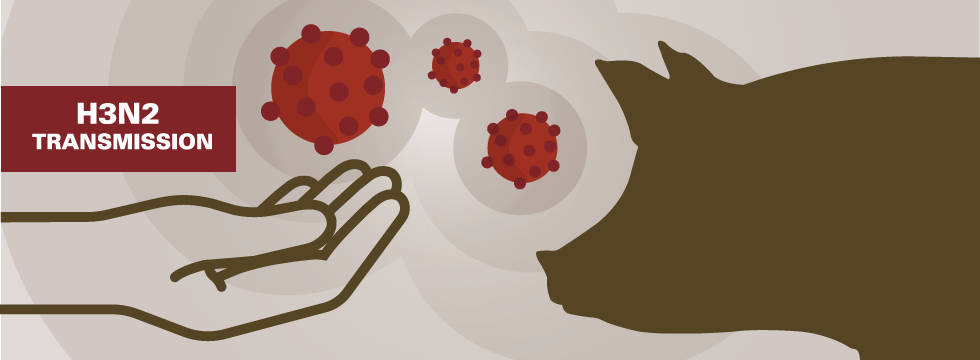
Human Seasonal H3N2 Awareness for Swine Workers and Veterinarians
- Influenza A viruses (IAV) are shared between humans and pigs, and human seasonal IAV introductions into pigs have largely driven the genetic diversity of swine IAV.
- When human seasonal IAV infect pigs, some do not transmit or spread, but some continue transmission and may lead to widespread outbreaks and new endemic swine strains.
- Endemic swine strains may also cause zoonotic infections in people, and are known as variant IAV (H3N2v, H1N1v, H1N2v).
- At least four independent human seasonal H3N2 have been detected in pigs by USDA IAV swine surveillance since 2010, and H1N1pdm09 continually transmits from people to pigs.
- An H3N2 from the 2010-2011 human flu season became endemic in swine and is now the dominant swine H3N2 according to USDA surveillance data. This strain, now adapted to swine, caused dozens of human variant infections associated with swine exposure in 2016 and 2017.
- The CDC reports high levels of influenza related illnesses, widespread activity across the U.S., and that H3N2 is most frequently detected in association with illness and hospitalization. The percentage of pneumonia and influenza mortality has risen above the epidemic threshold as reported in FluView, January 13, 2018.
- Individuals with occupational exposure to swine are reminded to follow recommended influenza biosecurity practices:
- Receive the human seasonal influenza vaccine with human health care professional approval. This may reduce human-to-swine transmission of human IAV.
- Establish and follow employee sick leave policies for influenza-like illness on swine farms.
- Follow disease control practices and precautionary measures to prevent infection with IAV in pigs and/or workers.
- Monitor for influenza in swine herds and participate in the USDA IAV swine surveillance.
- Enhance personal protection if an outbreak is suspected or confirmed in the pig population (such as wearing N-95 respirators and disposable gloves, frequent hand-washing, avoid touching eyes, nose, and mouth, etc.).
- For more information or what to do if you suspect an influenza outbreak in your swine herd, see the links below:
The American Association of Swine Veterinarians position statement on IAV is listed below:
Influenza A viruses (IAVs) are a cause of respiratory disease in swine that can decrease pig performance, negatively affect health, and are sporadically transmitted to and from humans. The emergence of the pandemic (H1N1) 2009 influenza virus reminded us of the importance of cross-species transmission of influenza viruses. The continuous presence of a diverse array of IAVs in the swine population makes it apparent that reducing the burden of disease caused by IAV is important.
It is the position of the AASV that we
- promote research and surveillance programs for IAV with the goal of discovering effective methods to control disease through farm-specific efforts, including but not limited to improved vaccines;
- encourage veterinarians and producers to review the IAV health plan including the vaccination of swine with approved IAV vaccines according to label directions and based on veterinary recommendation for strain matching;
- support the recommendation that people working with swine take all available precautions, including vaccination (with their human health professional’s approval), to prevent infection with influenza; and
- recommend pork producers, swine veterinarians and diagnostic laboratories actively participate in IAV surveillance programs that provide information regarding IAV evolution and epidemiology.
